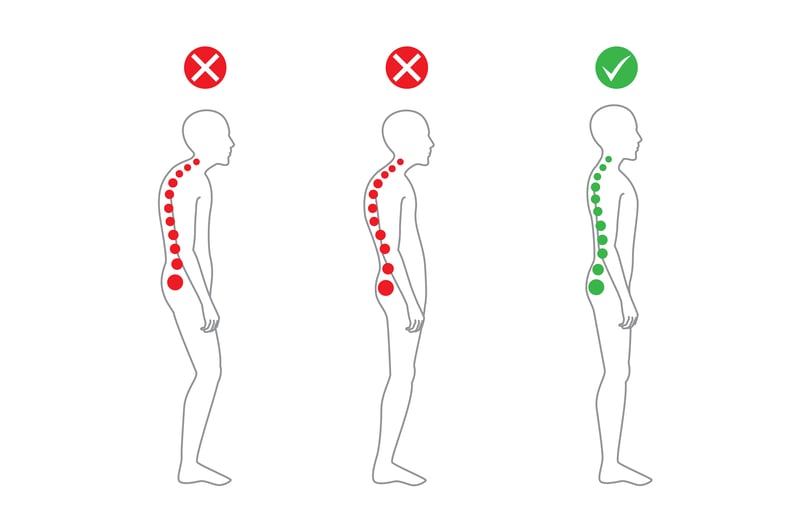Is Your Body Out of Alignment? These 8 Exercises Can Help

Finding balance is important, and that goes for all aspects of life, including your health and fitness. But, with so many other tasks and stressors tugging at your time and attention on a daily basis, most folks find little, if any, time to work on their body alignment. Yet everyone could use a little straightening out when it comes to body alignment.
Posture, Alignment, and Muscle Imbalances
Health is much more than just a clean bill from the doctor or a lean and toned physique. A healthy body is also one that is in alignment and doesn’t have poor posture or muscular imbalances.
We pretty much all know poor posture when we see it. For example, when we see someone who hunches their back, walks with a slouch, or has rounded shoulders, we can see something is not quite right. But what does good posture look like? Good posture is when you properly hold your body in alignment with your spine straight, head over shoulders, shoulders over hips when sitting, standing, walking, and even lying down.
Being in proper alignment means your body is typically positioned in a manner which puts the least amount of stress and strain on your muscles, tendons, ligaments, spine, and joints.
What Causes Poor Body Mechanics and Posture?
Since our bodies are a conglomerate of bones, muscles, and joints, it’s easy to see that if one area is injured, other neighboring or opposing areas may need to make adjustments to protect the weakness in the injured area.
Muscular imbalances can happen when you’re misaligned and your body reacts by overcompensating in other areas to protect the weak or injured area. Imbalances can also occur because of tightness, overuse injuries (especially from repetitive motions), being sedentary, your sleep position, how you sit for long periods of time, poor posture, and even from working out improperly.
With both dynamic posture (how your body is aligned during movements like walking, running, or taking the stairs) and static posture (like sitting or standing) being a concern, there are many ways your body can become misaligned, so working toward proper posture and improving body alignment is a good idea.
What Are the Benefits of Proper Body Alignment?
- Fewer headaches—believe it or not, being properly aligned can help relieve stress on your head, neck, and shoulders, which in turn can alleviate a common cause of headaches.
- Less injury—with your body in proper alignment, muscles, tendons, and ligaments can effortlessly stretch within their full range of motion, and your body can function at its maximum capacity.
- Less overall pain—improved alignment means your muscles, joints, tendons, and ligaments won’t have to undergo undue stress or overworking/overcompensating. When you have proper balance, you will have proper strength and endurance as well.
- Look leaner and taller.
- Better sports performance.
- Improved digestion.
- Better circulation.
Try These Exercises to Improve Your Body Alignment
Your body needs to be strong yet supple and flexible to maintain proper body alignment. A strong core will provide a good base for proper alignment, so doing a number of exercises on a regular basis that strengthen and build your core is a good idea and can go a long way toward helping you maintain or regain proper body alignment.
To increase your flexibility and range of motion (also helpful when it comes to alignment), doing some yoga poses can really help you improve. You can also glean many additional side benefits from yoga, such as better circulation, less stress, improved mood, less chronic pain, better sleep, and increased protection from injury.
So, incorporating exercises that help you strengthen your core, while also increasing flexibility, is a great start when it comes to improving your body alignment.
- Side neck stretch. Sit on the ground with your legs crossed and your back straight and your head facing forward. Take your right arm and place it over your head with your palm over your left ear. Very gently pull your head laterally to the right side until you feel a nice stretch through the left side of your neck. Hold this stretch for five breaths and then repeat on the opposite side.
- Forward and back neck stretch. From your seated position, continue your gentle neck stretches by letting your head drop slowly forward toward your chest. Feel a stretch through the back of your head and neck. Hold for five breaths and then bring your head back to the upright position. Next, let your head drop gently backwards until you’re looking up at the ceiling. Feel a stretch through the front of your neck and some of your chest. Hold for five breaths and then return to your normal head position.
- Spine Mobility. Begin on the ground on your hands and knees. Your palms should be flat on the floor, directly underneath your shoulders, with your fingers spread out. Next, sit back onto your heels and allow your left forearm to rest on the ground while placing your right hand behind your head. Rotate your back while twisting your head to the right and rotating your elbow upwards. Once you feel a good stretch through your spine, hold the movement for five deep breaths and then return to the start. Repeat on the opposite side.
- Corner Stretch. This stretch for tight chest muscles can help reduce the tendency to round your shoulders and hunch your back. Just loosening these muscles is a great start toward better alignment. Begin by standing in a doorway or a corner. Leaning slightly forward, place your forearms on opposing walls or corners and allow your body to lean forward, feeling a nice stretch through your chest and the front shoulder muscles. Hold this position for three deep breaths and return to your normal standing position. Release and relax your shoulders back, and repeat five times.
- Hip Flexor Stretch. This stretch can really help with alignment as many folks experience tightness in this region, which can contribute to lower back pain and poor posture. Start by standing with your feet hip-width apart. Take a giant step forward with your right leg. With your hands on your hips, slowly bend your right knee. Your left leg will automatically begin to straighten and you should feel a stretch through the front of your left hip. Hold this position for five deep breaths and then push through your right heel to return to the standing position. Repeat on the opposite side.
- Child’s Pose. This yoga stretch is helpful for releasing tension from your glutes, hamstrings, lower back, and neck while helping lengthen your spine. Sit back on your heels on the floor. Place your palms in front of you on the ground, face down, and slide them forward as you simultaneously move your hips backwards as far as you can. Once your torso is fully elongated and your forehead is resting on the ground, hold this position for five to ten deep breaths and then return to a seated position.
If this is too much for your shoulders, place your forehead on a block or a pillow as you allow your back to fully relax. Depending on what feels more comfortable to you, you can keep your knees together or open them to rest your torso between your legs.
- High Plank. As discussed, having good posture means having a strong and stable core. Begin on your hands and knees on the ground. Straighten your legs behind you so you are on your toes. Next, straighten your arms completely so they are about shoulder-width apart with your elbows lined up under your shoulders, palms down. Your body should be in a straight line. Hold this position for 20 seconds and then return to your hands and knees.
- Downward Dog. Start by standing with your feet a little more than hip-width apart. Bend down and place your hands on the ground in front of you and walk them forward as you straighten your legs. Once your legs are completely straight, straighten your arms as well so your body forms an inverted “V.” Keep your ears aligned with your arms and enjoy the stretch you feel throughout your hamstrings, back, chest, shoulders, and arms. Hold this position for five deep breaths and then return to a standing or kneeling position.




 7 Signs Your Body is Seriously Low on Collagen (not just wrinkles)
7 Signs Your Body is Seriously Low on Collagen (not just wrinkles) Health Expert: "Turmeric Doesn't Work (unless...)"
Health Expert: "Turmeric Doesn't Work (unless...)" 3 Warning Signs Your Probiotic Supplement is a Total Waste
3 Warning Signs Your Probiotic Supplement is a Total Waste

